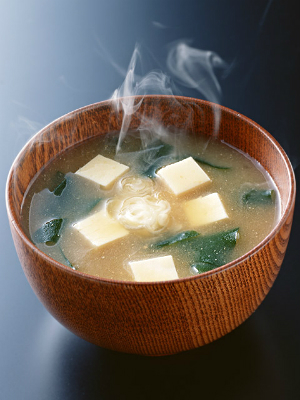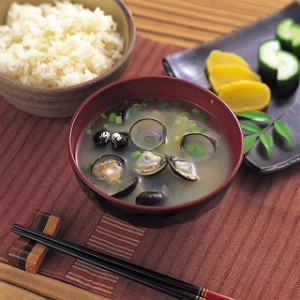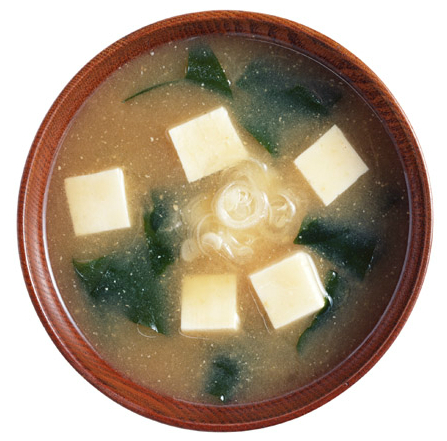Miso soup | Articles on Japanese Restaurants | Japan Restaurant Guide by Gourmet Navigator
Miso Soup Summary

Miso soup is an indispensable part of everyday meals in Japanese households. It is a type of soup prepared with soup stock made from small dried sardines, dried bonito flakes, and/or kombu seaweed and seasoned with miso. Miso soup is the most popular soup dish and served both at upscale Japanese restaurants and regular diners or prepared at home as a family dish. It is also called "omiotsuke."
Wasyoku(Japanese Cuisine) encyclopedia : Miso Soup

A wide variety of ingredients such as soy products like tofu and deep fried sliced tofu, seaweed such as wakame, shell fish like basket clams and sea turban, and vegetables such as Daikon radish, carrots, or egg plants are put inside the soup. The variety of ingredients characterizes the season, geographical region, and household tradition. Some miso based soups are called by special names because of the specific ingredients that are used. To be more exact, miso soup with pork is called “Butajiru or Tonjiru (pork soup),” soup with fish seasoned with salt or sake lees is called “Sanpeijiru.” Most basic Japanese menu consisting of rice, miso soup, pickles and another dish is called “One soup and three dishes” and is considered an ideal menu. Especially, together with other dishes, miso soup can stimulate appetite, and soy beans contained in miso served as an important source of protein for Japanese meals that tended to lack sufficient amount of protein in the old days.
In addition, miso contributed a lot to supplement salt that human body needs. It is said that miso soup began to be consumed as part of regular family meals during the Muromachi period. Originally, it was a countryside dish mostly prepared by farmers, but it gradually spread to other social classes, and eventually became an indispensable part of Japanese meals. There is also a theory that miso soup was created as a quick meal in the battle field during the Sengoku period (Warring state era) since it is easy to make in large quantity. In fact, there are various local specialty miso that is said to have been invented by the famous war generals such as Echigo miso by Uesugi Kenshin and Sendai miso by Date Masamune. By the Edo period, miso soup was consumed in almost all households in Japan. For commoners, the combination of rice, miso soup, and pickles was the regular daily menu. Originally, miso was a type of preserved food made with salted soy beans and was eaten directly by taking a small amount of it. Popularization of miso soup greatly contributed to changing its position from a preserved food to condiment.

Scallions, myoga, and grated daikon raddish can be added as condiments, and adding bonito flakes, nori, or aonori can be delicious. It can also be placed on cold tofu called "hiyayakko", or eaten with other sticky foods like chinese yam, mekabu,or okra, and is popular as a healthy dish. In Hokkaido and the Tohoku region, adding sugar is common, and in Fukushima prefecture it is sometimes eaten with pickled Chinese cabbage. It can be used as an ingredient for miso soup, and "natto soup" which uses chopped natto was eaten more frequently than with rice during the Edo period. it can be added to soba, udon, spaghetti, Japanese curry, okonomiyaki, and tempura. A "natto makzuki" made by making makizushi with natto is very popular, and it can be seen as a regular product in convenience stores.








